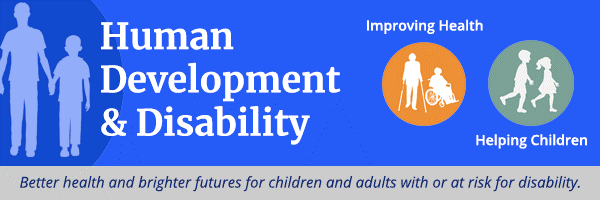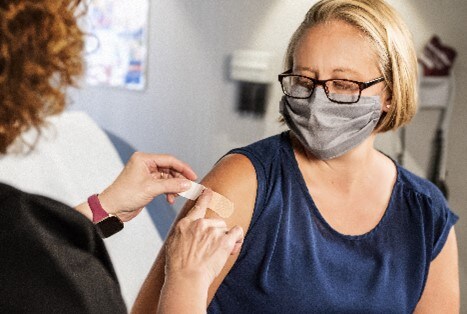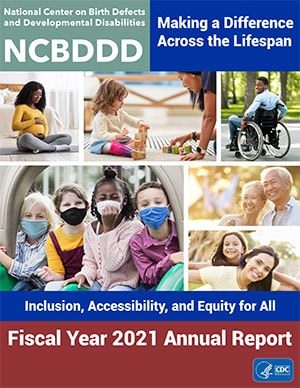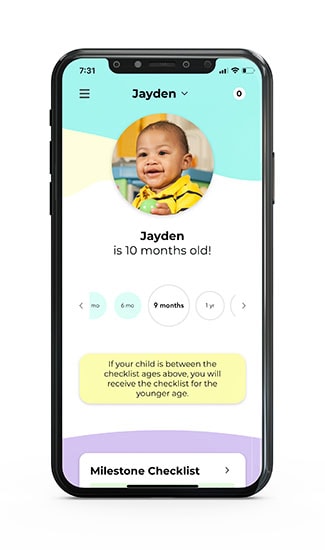DHDD Newsletter – January 2022

A Note from the Acting DHDD Director:
Dear DHDD Partners,
I hope your 2022 has been off to a great start. NCBDDD and DHDD have been engaged in very fruitful discussions with some of our partners about how to improve disability inclusion for public health emergency responses. We have also been off to a very busy start this month. Note information below about two open CDC Funding Opportunities as well as multiple publications of interest. Please also remember that we have a number of COVID-19 resources available for people with intellectual and developmental disabilities, direct care providers, and health care professionals on our DHDD health equity site. Please share these resources with your networks. We continue to build out this site and are hoping to soon add resources and links specific to parents and caregivers of children with disabilities. Stay tuned!
Best,
Blythe
In the Spotlight
NCBDDD’s Fiscal Year 2021 Annual Report Now Available
NCBDDD’s Fiscal Year 2021 Annual Report is now available. NCBDDD continues to be proud of the work our staff, partners, and grantees are doing from day-to-day, and progress that we’re making around so many critical topics during these historic times.
New Funding Announcement: Improving and evaluating measures to identify tics and tic disorders including Tourette syndrome in children in epidemiologic studies and clinical settings.
A Notice of Funding Opportunity for supplemental funding for currently-funded Prevention Research Centers (RFA-DP-19-001) to conduct Special Interest Projects has been published, which includes the project, Improving and evaluating measures to identify tics and tic disorders including Tourette syndrome in children in epidemiologic studies and clinical settings (SIP 22-003). This project will help to improve (a) early identification and treatment of tics to improve outcomes among people with tic disorders and co-occurring conditions; and (b) how tic disorders, including Tourette syndrome (TS), are defined and measured. This information will increase our understanding of how many people have TS, particularly among minority and underserved populations through testing and evaluating the use and accuracy of measures to identify tics and tic disorders in a demographically diverse sample of children from the general population.
Access the RFA and Application package. See pages 6 and 58-64 in the attachment (or search “Tourette”). Application due date is 3/4/2022.
Now Open for Applications for CDC Funding Opportunity – Health Promotion and Disease Prevention Research Centers: 2022 Special Interest Project Competitive Supplements (SIPS)
CDC has issued a Notice of Funding Opportunity for Prevention Research Centers currently funded under CDC RFA-DP-19-001 to conduct Special Interest Projects to design, test, evaluate, disseminate, and translate effective, applied public health prevention research in the United States.
The Division of Human Development and Disability is sponsoring a project through this funding opportunity entitled, Disability and Health Data Collaborative: Using Data to Promote the Health and Wellness of People with Disabilities. The purpose of this project is to implement a multi-site research study and establish a framework for a Disability and Health Data Collaborative using state Medicaid data and data linkages to better characterize and evaluate the health and wellness of people with intellectual and developmental disabilities. We invite our partners to learn more about this opportunity here. The application closing date is Friday, March 4, 2022.
New Resources
Downloads of CDC’s Milestone Tracker app surpasses 1,000,000
Milestones matter! Parents and caregivers can track their child’s milestones from age 2 months to 5 years with CDC’s easy-to-use illustrated checklists. They can also get tips from CDC for encouraging their child’s development, and access information about resources that can help if a parent or caregiver is ever concerned about how their child is developing.
Thank you to all of our partners for helping us reach one million downloads of CDC’s Milestone Tracker app! This would not have been possible without your partnership, promotion, and support.
Publications
Assessing language and communication development in children

A new CDC study published in Academic Pediatrics examines national data on a brief pilot measure of language and communication development for children ages 1-5 years on the National Survey of Children’s Health (NSCH). The study found that patterns of responses to the 11 questions piloted in the survey were overall consistent with age milestones defined by existing measures of early language and communication development. The brief NSCH pilot measure may be useful for informing and monitoring efforts to promote early language and communication development on a population level.
Developmental Monitoring and Referral for Low Income Children Served by WIC: Program Development and Implementation Outcomes
A new paper in the Maternal Child Health Journal describes the evaluation of a project implementing CDC’s Learn the Signs, Act Early. campaign in the Special Supplemental Nutrition Program for Women, Infants, and Children (WIC) at 20 demographically diverse WIC clinics in eastern Missouri. As part of this project, parents were asked to complete developmental milestone checklists for their children. All surveyed staff (n = 46) agreed the program was easy to use, and most staff (≥ 80%) agreed that checklists fit easily into clinic workflow and required ≤ 5 minutes to complete. According to 80% of staff, parents indicated that the checklists helped them learn about developmental monitoring and planned to share them with their healthcare providers. The program has potential to complement and strengthen existing community-based systems of care for early detection in young children experiencing poverty.
Ensuring Equitable COVID-19 Vaccination for People With Disabilities and Their Caregivers

A new CDC commentary outlines the most common challenges to equitable COVID-19 vaccination reported by respondents and ways jurisdictions addressed those challenges. Authors conclude that people with disabilities face unique barriers to COVID-19 vaccination. Using, enhancing, and developing public health systems may be a first step in removing vaccination barriers for this disproportionately affected population. Lessons learned from the COVID-19 pandemic may also be used to develop strategies to reach people with disabilities during other public health emergencies.
Features that Best Define the Heterogeneity and Homogeneity of Autism in Preschool-Age Children: A Multisite Case-Control Analysis Replicated Across Two Independent Samples

The diverse nature of autism spectrum disorder (ASD) makes it difficult to find risk factors and treatment options. A new CDC study identified the most dissimilar and most similar symptom(s) in children classified as having ASD and as having subthreshold ASD characteristics. Factors associated with dysregulation (e.g., aggression, anxiety/depression, sleep problems) and developmental abilities (e.g., expressive, and receptive language skills) most contributed to diversity in both groups of children. Sensory dysfunction was the most common symptom in children with ASD but not those with subthreshold characteristics. These findings suggest that dysregulation and developmental abilities are associated clinical features that can impact functioning in children with autism and other developmental delays, and that documenting these features in pediatric records may help meet the needs of the individual child. Sensory dysfunction could be considered a core feature of ASD and thus used to inform more targeted screening, evaluation, treatment, and research efforts.
Peri-Pregnancy Cannabis Use and Autism Spectrum Disorder in the Offspring: Findings from the Study to Explore Early Development
Authors of a study published online in The Journal of Autism and Developmental Disorders explored whether maternal cannabis use prior to or during pregnancy was associated with autism spectrum disorder (ASD). They found that cannabis use was no more or less common among mothers of children with ASD compared to mothers of children with other developmental disabilities or from the general population. In light of the increasing number of states legalizing or decriminalizing recreational cannabis use, along with plausible potential effects based on underlying neurobiology and animal models, larger studies with more detailed information on the frequency, amount, and mode of cannabis intake prior to and during pregnancy are needed.
New CDC Study Findings Can Help Improve Consistency of Autism Diagnoses in Clinical Settings

A new CDC study reports on a process to detail the Diagnostic and Statistical Manual, 5th edition (DSM-5) diagnostic criteria for autism spectrum disorder (ASD). In this study, a team of clinicians identified and mapped specific exemplars for each of the seven core DSM-5 diagnostic criteria and associated features to CDC’s ASD surveillance criteria based on DSM-IV-TR, DSM-5 text, and diagnostic assessments, with the goal of providing greater specification of the criteria for clinicians to apply when identifying the features of ASD. The team found that a diverse group of clinicians across multiple sites can reliably apply a detailed guide to endorsing the DSM-5 ASD criteria regardless of child sex, race/ethnicity, or cognitive level. This framework can be used to inform the development and evaluation of tools and training for clinical, research, and surveillance efforts, while also providing confidence in the consistency of CDC’s prevalence estimates from the Autism and Developmental Disabilities Monitoring Network based on these methods.
Opportunities for Public Comment
- The United States Core Data for Interoperability (USCDI) is a standardized set of health data classes and constituent data elements for nationwide, interoperable health information exchange. The first draft of USCDI version 3 was published and it now includes disability status. Public comments will be accepted until April 30, 2022, on the main draft USCDI v3 page or on individual data class or data element pages. More details are available on this website: United States Core Data for Interoperability (USCDI) | Interoperability Standards Advisory (ISA) (healthit.gov) (see left column and scroll down to “click to view Draft USCDI V3”).
- The U.S. Preventive Services Task Force has released a Draft Research Plan for Screening for Speech and Language Delay and Disorders in Children Age 5 Years or Younger. Public comments are being accepted January 20, 2022-February 16, 2022. To review the draft research plan and submit comments, go here.



